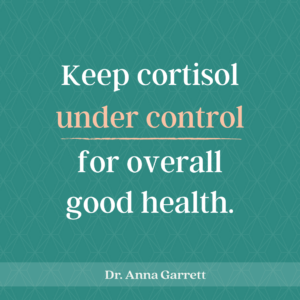Cortisol vs. Perimenopause
Women tend to chalk up all the annoying symptoms that arise in midlife to imbalances in estrogen and progesterone…and this can definitely be a contributor. But if you dig a little deeper, you are likely to discover that stress is really at the root of most of the chaos.
Here’s why.
Cortisol is the “mean girl” in your body’s neighborhood. She is completely disruptive, partying at all hours of the day and night when your stress is constant. And she’s keeping everyone else in the hormone neighborhood jacked up and wonky as well.
Let’s Take a Look at What is Happening When Cortisol is Running The Show in Your Body:
Stress derails progesterone’s work.
Cortisol can block your body’s progesterone receptors. So, you may have plenty of progesterone being made, but if cortisol is sitting in progesterone’s seat, then it can’t do its job. The body makes cortisol at the expense of all other hormones, and progesterone can be used to make cortisol if needed, so this is another possible reason for low progesterone.
Cortisol decreases sensitivity to estrogen.
When cortisol is high in the brain, it is less sensitive to estrogen. Hot flashes are a symptom of estrogen deficiency under normal circumstances. In this case, though, it’s a signal that cortisol has altered brain sensors. That’s why hot flashes can occur in women who have reasonable estrogen levels but are experiencing lots of stress. If estrogen is added with the intention of treating hot flashes in a woman whose estrogen levels are reasonable, the outcome will be weight gain in the hips, water retention, and mood swings; all signs of too much estrogen. And the hot flashes won’t go away.
Thyroid hormone and cortisol depend on each other.
One of cortisol’s more important functions is to work with thyroid hormone at the cellular level. Cortisol makes the thyroid work more efficiently. A balanced amount of cortisol (not too high or low) is very important for normal thyroid function. Therefore, many women who have an imbalance in cortisol levels may have low thyroid symptoms but still have normal results on a thyroid test.
Every cell in the body has receptors for both cortisol and thyroid, and almost every process that goes on in cells requires the thyroid to be humming along at peak performance levels. Too much cortisol can create a problem of thyroid resistance where the tissues fail to respond to the hormone. This resistance also happens with other hormones like insulin, progesterone, estrogen, testosterone, and even cortisol itself. Resistance means the body has to work harder and harder to make more of the other hormones when cortisol is high. The bottom line is that chronic stress makes you feel rotten because none of the hormones are allowed to function as they should.
Cortisol contributes to insulin resistance and overeating.
Under stressful conditions, cortisol provides the body with glucose by tapping into protein stores. This energy helps you fight or flee a stressor. However, elevated cortisol consistently produces too much glucose, increasing blood sugar levels. Since one of the main functions of cortisol is to counter the effects of insulin, essentially rendering the cells insulin-resistant, the body remains in a general insulin-resistant state when cortisol levels are chronically high.
Over time, the pancreas struggles to keep up with the high demand for insulin, glucose levels in the blood remain high, the cells cannot get the sugar they need, and the cycle continues. Consistently high blood glucose levels along with insulin suppression lead to cells that are starved of glucose even when blood levels are high. But the cells are still crying out for energy, sending hunger signals to the brain. This can lead to overeating, and any unused glucose becomes body fat.
DHEA can’t protect against the effects of cortisol.
DHEA (dehydroepiandrosterone) is one of your male hormones (androgens). The other is testosterone. This flexible hormone turns into either testosterone or estrogen in the hormone cascade. For women, it is more likely to head down the testosterone route. In men, it’s the opposite.
DHEA works against the effects of cortisol and, because of this, is a potent anti-aging hormone. Since cortisol and DHEA have opposing effects, they are usually viewed together as a ratio.
When cortisol is elevated disproportionately to DHEA, the ratio is high. A healthy DHEA: cortisol ratio is 5:1. A high ratio can result in the following:
- Increased inflammation
- Poor immune function
- Insulin resistance
- Compromised thyroid, pancreas, and ovarian function
- Inability to detoxify heavy metals
- Bone breakdown
- Poor memory
The Bottom Line
 Keeping cortisol under control is critical for overall good health. The best cortisol testing methods are with saliva or urine (DUTCH) with samples taken at 4 or 5 points during the day. This approach shows the cortisol pattern during the day as well as the levels of the hormone. The benefit of urine testing is that it allows a look at cortisol metabolites and cortisone (an inactive form of cortisol). A deep dive into how your body handles stress allows health care providers to pinpoint and address issues with the central stress response system.
Keeping cortisol under control is critical for overall good health. The best cortisol testing methods are with saliva or urine (DUTCH) with samples taken at 4 or 5 points during the day. This approach shows the cortisol pattern during the day as well as the levels of the hormone. The benefit of urine testing is that it allows a look at cortisol metabolites and cortisone (an inactive form of cortisol). A deep dive into how your body handles stress allows health care providers to pinpoint and address issues with the central stress response system.
Dr. Anna Garrett is a menopause expert and Doctor of Pharmacy. She helps women who are struggling with symptoms of perimenopause and menopause find natural hormone balancing solutions so they can rock their mojo through midlife and beyond. Dr. Anna is the author of Perimenopause: The Savvy Sister’s Guide to Hormone Harmony. Order your copy at www.perimenopausebook.com.
Dr. Anna is available for 1-1 consultation. Find out more at www.drannagarrett.com/lets-talk




